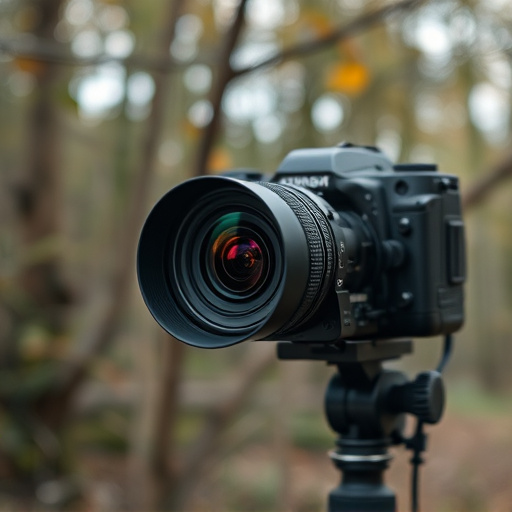Invisible IR cameras transform home monitoring with heat-signature technology, offering night vision and wall penetration. Legal and ethical considerations, including privacy laws and consent, are crucial for installation. Strategic placement and professional integration ensure optimal performance while balancing security and privacy. These advanced systems provide 24/7 remote access via real-time alerts and encryption, enhancing safety without compromising residential privacy.
In today’s digital era, the demand for discreet security solutions is on the rise. This comprehensive guide explores the professional placement of covert monitoring systems, focusing on invisible IR camera technology. We delve into legal and ethical considerations surrounding home monitoring, offering strategic insights for effective system integration. Learn best practices for securing and maintaining these innovative tools, ensuring optimal performance while navigating the complexities of private space surveillance.
- Understanding Invisible IR Camera Technology
- Legal and Ethical Considerations for Home Monitoring
- Professional Placement Strategies for Covert Systems
- Integrating Discreet Cameras into Security Solutions
- Best Practices for Securing and Maintaining covert monitoring systems
Understanding Invisible IR Camera Technology
In the realm of home monitoring, invisible IR camera technology has emerged as a discreet yet powerful tool. These innovative devices operate by capturing heat signatures, allowing them to see in complete darkness and through obstacles like walls and curtains—features that make them ideal for enhanced security and surveillance. Unlike traditional cameras that rely on visible light, infrared (IR) cameras detect electromagnetic radiation, transforming it into an image based on temperature variations.
This technology is particularly useful for invisible home monitoring, offering a level of privacy and versatility unmatched by visible-light cameras. Whether installed indoors or outdoors, IR cameras can provide clear images day or night, making them valuable assets for professional security systems. Their discreet nature ensures they blend seamlessly into the environment while delivering advanced monitoring capabilities for peace of mind.
Legal and Ethical Considerations for Home Monitoring
When implementing a home monitoring system, especially using advanced technologies like an invisible IR camera, it’s paramount to navigate the legal and ethical landscape meticulously. Privacy laws and regulations vary across regions, with many nations having strict guidelines on the use of surveillance equipment within residences. These rules are designed to protect individuals’ right to privacy and prevent potential abuse of monitoring technology.
Ethical considerations further underscore the importance of transparency and consent in home monitoring. Installing an invisible IR camera without informed consent raises serious ethical concerns. Homeowners should be fully aware of the monitoring system’s presence, its capabilities, and how their data will be used. Adhering to these legal and ethical guidelines ensures that home monitoring remains a powerful tool for safety and security while respecting personal privacy rights.
Professional Placement Strategies for Covert Systems
When implementing a covert monitoring system, such as an Invisible IR Camera for home monitoring, strategic professional placement is key to its success. The first step involves identifying the areas that require surveillance. This could include high-traffic common areas in residential or commercial spaces, or specific rooms where sensitive activities occur. Discreetly positioning the cameras in these areas ensures maximum coverage without raising awareness.
For optimal results, consider hiring professionals with expertise in integrating such systems into existing infrastructure. They can advise on the best camera placements for both visibility and privacy. Additionally, employing experts guarantees that the system operates at peak performance, enhancing the overall effectiveness of home or business monitoring using invisible IR cameras.
Integrating Discreet Cameras into Security Solutions
In today’s digital era, enhancing home security has become a top priority for many homeowners. One effective way to achieve this is by integrating discreet cameras into their security solutions. Invisible IR cameras, in particular, offer an advanced level of protection with their ability to capture high-quality footage even in complete darkness. These cameras are designed to blend seamlessly into the environment, often resembling everyday household items like light switches or power outlets, making them virtually undetectable to potential intruders.
The use of such innovative technology provides homeowners with a sense of peace of mind, allowing them to remotely monitor their properties 24/7. Discreetly placed cameras can detect and record any suspicious activity, ensuring immediate response to potential threats. With real-time alerts and high-resolution footage, homeowners can efficiently navigate security concerns, making professional monitoring systems a valuable asset for any home.
Best Practices for Securing and Maintaining covert monitoring systems
When securing and maintaining covert monitoring systems, such as Invisible IR Cameras for home monitoring, it’s crucial to follow best practices that ensure both effectiveness and ethical deployment. First, discreet placement is key; strategically locate cameras in hard-to-see areas while ensuring optimal coverage. This minimizes the risk of detection and maintains the surveillance system’s integrity. Regular maintenance checks are equally vital; inspect cameras for any signs of damage or obstruction, and replace batteries or power sources as needed to ensure continuous operation.
Additionally, strong encryption protocols must be implemented to protect video feeds from unauthorized access. Using secure networks and advanced encryption standards, like AES, safeguards sensitive data. It’s also essential to comply with local laws and privacy regulations regarding surveillance. Regular reviews of system logs and monitoring practices can help identify any anomalies or potential misuse, ensuring the system remains a powerful tool for security without infringing on personal privacy.
The integration of invisible IR camera technology in home monitoring offers enhanced security, but it’s crucial to balance this with legal and ethical considerations. By understanding the capabilities and limitations of these systems, professionals can employ effective placement strategies to ensure optimal protection without infringing on privacy rights. Adhering to best practices for securing and maintaining covert monitoring systems is essential to guarantee their longevity and reliability, making them valuable tools in today’s security landscape.
